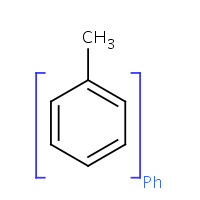
First, the whole molecule should be built using the Core API methods, or imported. In this example, we import it from SMILES format. Then the SuperatomSgroup is constructed with the molecule in the argument of the constructor.
Molecule mol = MolImporter.importMol("C1=CC=CC=C1C");
Cleaner.clean(mol, 2, null);
// Create the Sgroups.
SuperatomSgroup superSg = new SuperatomSgroup(mol);
In order to set subscript of a Superatom S-group, use the
SuperatomSgroup.setSubscript(String) method:
superSg.setSubscript("Ph");
The atoms that are supposed to be a part of an S-group should be added to it (that is, set the S-group as the parent of the MolAtom). In our example, we add the carbon atoms of the benzene ring to the S-group, they are the first six atoms of the molecule.
for (int i = 0; i < 6; i++) {
mol.setSgroupParent(mol.getAtom(i), superSg, true);
}
superSg.calculateAttachmentPoints();
In the argument of the Molecule.setSgroupParent() method,
MolAtom represents the atom to be added to the
Superatom S-group superSg. If the value of the boolean parameter
is true, the atom will be added to the S-group,
otherwise it will be removed from there. The molecule now is inconsistent, because
an attachment point is missing from the Superatom S-group. Use the
SuperatomSgroup.calculateAttachmentPoints()
method to add automatically, or use the
SuperatomSgroup.addAttachmentPoint(MolAtom)
method to add manually the missing attachment points.
Since Marvin 6.0, we support to add S-group attachment point only to atoms
that are part of a Superatom S-group.
Attachment points are represented by an object which stores its attach atom,
crossing bond and order.
The attach atom is one of the MolAtoms of the superatom S-group
on which the attachment point is placed.
The crossing bond is a bond where
When an attachment point is free, the crossing bond is null, further crossing bond addition is possible. The order is an integer greater than zero defining the priority of the attachment point. When a bond is added to a contracted superatom S-group, it occupies a free attachment point with the lowest order.
To add an attachment point, use one of the following methods:
SuperatomSgroup.addAttachmentPoint(MolAtom);
SuperatomSgroup.addAttachmentPoint(MolAtom, int order);
In the first case, the smallest unused number is set as order.
Crossing bond can be added to an attachment point by invoking
SuperatomSgroup.addCrossingBond(MolAtom attachAtom, MolBond crossingBond)
method. However, the crossing bond information is updated automatically by
Molecule.add(MolBond bond) method.
Note, that the method MolAtom.setAttach(int) is deprecated,
and its usage is not recommended any more.
By invoking SuperatomSgroup.calculateAttachmentPoints(),
attachments points are put to atoms in the superatom S-group that have bond
which other end atom is outside the group (crossing bond).
It is useful when the superatom S-group is created using the
SuperatomSgroup.setSgroupGraph() method.
Attachment point information of a superatom S-group
can be received by calling method SuperatomSgroup.getAttachmentPoints().
The result is an java.util.ArrayList of AttachmentPoint
objects from the superatom S-group. The list is sorted by increasing attachment point orders.
Note, that the method MolAtom.getAttach() is deprecated,
and its usage is not recommended any more. The orders of the attachment points
located on a given atom can be obtained by invoking method
SuperatomSgroup.getAttachmentPointOrders(MolAtom).
It returns the ArrayList<Integer> of attachment point orders
located on the given MolAtom.
Full example of building of polystyrene can be found at the Code examples.
Sgroup.XSTATE_XC where the
S-group remembers its previous contracted
state but the represented atoms were moved to the molecule graph
and the abbreviation (SgroupAtom) was removed from the molecule
graph. Set this state on all Sgroups by calling
Molecule.setGUIContracted(false) or by calling
Sgroup.setGUIStateRecursively(false) individually on Sgroup-s.
Example for a typical usage is a non-GUI related API
based calculation where we need the represented atoms in the
molecule graph instead of the abbreviation.
Sgroup.XSTATE_X)
the represented atoms are present in the parent molecule.
In the case of contracted S-groups (called Sgroup.XSTATE_C)
the abbreviation (SgroupAtom) is present in the parent
molecule. Set this state on all Sgroups by calling
Molecule.setGUIContracted(true) or by calling
Sgroup.setGUIStateRecursively(true) individually on Sgroup-s.
Note:
When Molecule.isGUIContracted() returns true and afterwards you call:
Molecule.setGUIContracted(false);
Molecule.setGUIContracted(true);
the second setGUIContracted call will restore the state before
the first setGUIContracted call!
AminoAcidSgroups are special SuperAtomSgroups to represent amino acids. The construction of these groups are exactly the same as the SuperatomSgroups. There are two additional attributes - the one letter and the three letter name of the amino acid.
Repeating unit S-groups are used to represent polymers and other repeating units.
In order to construct a repeating unit S-group object, use its constructor as
RepeatingUnitSgroup repeatingSg = new RepeatingUnitSgroup(Molecule mol, String connectivity, int type);
The parameter Molecule object will be the parent of the S-group
repeatingSg.
The String connectivity defines way the units connects to each other: "ht", for
head-to-tail; "hh", for head-to-head, and "eu" for either/undefined polymers.
The type of the S-group can be defined using the following constants:
Sgroup.ST_ANY,Sgroup.ST_SRU,Sgroup.ST_COPOLYMER,Sgroup.ST_CROSSLINK,Sgroup.ST_GRAFT,Sgroup.ST_MODIFICATION.Atoms and bonds can be added to a repeating unit S-group in a same way as to a Superatom S-group.
The bracket of this type of S-groups defines the repeating fragment of the polymer. Bonds that cross the brackets, called crossing bonds, define how the repeating units of the S-group connect.
The generateBracketCoord method of the
CleanUtil class generates brackets. As parameter the S-group
and the bracket type, square or round, should be added:
CleanUtil.generateBracketCoords(repeatingSg, MBracket.T_SQUARE);
The end groups of polymers are often unknown or unspecified which are represented by star atoms (*). Star atoms are defined with the
repeatingSg.addStarAtoms();
method.
Full example of building of polystyrene can be found at the Code examples.
|
Previous chapter |
Next chapter |